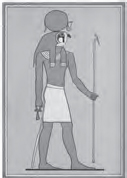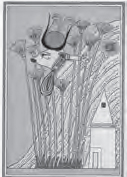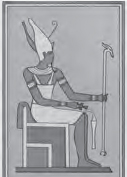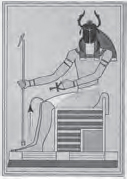 A
A
P ERHAPS CROWLEY'S greatest contribution to the technical practice of magick as a field of human endeavor was to inextricably link meditation and concentration to ceremonial and other forms of magick. Previous Adepts might teach and expound upon these things privately, but no one publicly stressed the importance of meditation to the extent that Crowley did. This, in fact, is one of the most important reasons his magical system works so well. It is practiced by people who have learned to focus their minds. He credited his focus on concentration and awareness practices to the influence of his two early mentors, Oscar Eckenstein and Allan Bennett.
You'll want to start a magical record. It can be a notebook or word-processing document, so long as you can record your practices and review under what circumstances you get the best results. Make notes about anything you think matters: the time of day, the weather, your mood, the positions of the planets, etc. 1 You'll forget a surprising amount of detail within hours, let alone days, after each exercise, so make your journal entries as soon as possible after you finish.
The suggested practices in this chapter are designed to help you develop daily awareness and one-pointed thought. Building upon such a foundation, your magical practices will become effective engines of your True Will. Without such a foundation, many “students of the occult” are simply fooling themselves.
These rituals are designed to wake the magician out of mundane consciousness, keeping at the forefront awareness of the self and one's place in the universe, while enhancing mindfulness of the Great Work. Although Crowley never called them “awareness rituals,” that is, in essence, what they are.
The first of these is the instruction on conscious eating. What better correlation than to link the body's need for food with the Aspirant's will to attain?
Using the handle of a knife, your index finger, or knuckles, tap the table three times, then five times, then another three. 3 If dining with another, this is conducted as a dialogue. If eating by yourself, you may adapt it as a monologue of simple first-person statements.
Do what thou wilt shall be the whole of the Law.
What is thy will?
It is my will to eat and drink.
To what end?
That I may fortify my body thereby.
To what end?
That I may accomplish the Great Work.
Love is the law, love under will.
(knocking once). Fall to!
While some have criticized this practice as “like saying grace,” it is also quite different. Although it shares the awareness of the sacred interaction of man and Nature, we don't ask a supreme being to bless our food. Instead, we pause in the midst of what, for many, is an automatic action (eating) to remind ourselves of why we're eating: That we may do the Great Work of discovering and accomplishing our True Wills. It transforms any meal into a magical, intentional act.
Another level of “awareness” ritual is “Liber Resh,” in which the passage of time and diurnal journey of the Sun becomes the occasion of daily spiritual focus.
“Liber Resh” 4 is an instruction to magically affirm the sun's course four times throughout the day: dawn, noon, dusk, and midnight. The practice of “Liber Resh” does one very simple thing very well: It causes the practitioner to stop whatever it is he or she may be doing and notice time's passing. And because this is done in a ritualized way, it helps the practitioner remember that whatever day-to-day routines we may have to follow to keep our daily bread on the table, there is a larger reason for this—and that reason is the Great Work.
0. These are the adorations to be performed by aspirants to the A A
A
1.Let him greet the Sun at dawn, facing East, giving the sign of his grade. And let him say in a loud voice:
Hail unto Thee who art Ra in Thy rising, even unto Thee who art Ra in Thy strength, who travellest over the Heavens in Thy bark at the Uprising of the Sun.
Tahuti standeth in His splendour at the prow, and Ra-Hoor abideth at the helm.
Hail unto Thee from the Abodes of Night!
2. Also at Noon, let him greet the Sun, facing South, giving the sign of his grade. And let him say in a loud voice:
Hail unto Thee who art Ahathoor in Thy triumphing, even unto Thee who art Ahathoor in Thy beauty, who travellest over the heavens in thy bark at the Mid-course of the Sun.
Tahuti standeth in His splendour at the prow, and Ra-Hoor abideth at the helm.
Hail unto Thee from the Abodes of Morning!
3. Also, at Sunset, let him greet the Sun, facing West, giving the sign of his grade. And let him say in a loud voice:
Hail unto Thee who art Tum in Thy setting, even unto Thee who art Tum in Thy joy, who travellest over the Heavens in Thy bark at the Down-going of the Sun.
Tahuti standeth in His splendour at the prow, and Ra-Hoor abideth at the helm.
Hail unto Thee from the Abodes of Day!
4. Lastly, at Midnight, let him greet the Sun, facing North, giving the sign of his grade, and let him say in a loud voice:
Hail unto thee who art Khephra in Thy hiding, even unto Thee who art Khephra in Thy silence, who travellest over the heavens in Thy bark at the Midnight Hour of the Sun.
Tahuti standeth in His splendour at the prow, and Ra-Hoor abideth at the helm.
Hail unto Thee from the Abodes of Evening.
5. And after each of these invocations thou shalt give the sign of silence, and afterward thou shalt perform the adoration that is taught thee by thy Superior. And then do thou compose Thyself to holy meditation.
6. Also it is better if in these adorations thou assume the God-form of Whom thou adorest, as if thou didst unite with Him in the adoration of That which is beyond Him.
7. Thus shalt thou ever be mindful of the Great Work which thou hast undertaken to perform, and thus shalt thou be strengthened to pursue it unto the attainment of the Stone of the Wise, the Summum Bonum, True Wisdom and Perfect Happiness.

Ra. The most common form of the sun god in Egypt is Ra. He represents the rising sun emerging new born each morning at dawn, the bringing forth of light or life from the darkness of night or death. His name is believed to derive from the verb “to create,” and his cultic center was in the city of Heliopolis.

Ahathoor. The goddess Hathor, the original Egyptian mother-goddess, is often depicted as a cow. She is the consort of the Bull of Amenti, and later became a sky goddess associated with the star Sept (Sirius). She is the patron of love and sometimes called the mother of Ra (her name literally means “House of Horus”). Many of her characteristics were later subsumed by the goddess Isis.

Tum. Tum, Atum, or Atem is the primeval, self-engendered god of ancient Egypt, his name literally meaning “Completed One,” i.e. one who created himself out of the primordial watery chaos. The epithet nefer (good) is often attached to his name, e.g. Nefer-Tum. Later he became associated with Ra, taking on the identity of Atum-Re, the setting sun.

Khephra. This god's name comes from the Egyptian root kheper “to create, to transform.” The root also refers to the scarab beetle. Scarabs fascinated the Egyptians because, laying their eggs in the unpromising medium of dung, they brought forth life and hence became symbols of resurrection and rebirth. The scarab beetle's habit of rolling dung into a ball in order to move it also symbolized what happened to the sun after it “perished” at dusk: the scarab god Khephra rolled it through the underworld and resurrected it back at the horizon at daybreak.
Now that we've identified our body's required daily actions of waking, sleeping, eating, and drinking, with the Will to attain, it is time to look at actual practices designed to focus the mind even more. The best of these are contained in “Liber E vel Exercitiorum sub figura IX,” 5 of which we present some extracts below.
1. It is absolutely necessary that all experiments should be recorded in detail during, or immediately after, their performance.
2. It is highly important to note the physical and mental condition of the experimenter or experimenters.
3. The time and place of all experiments must be noted; also the state of the weather, and generally all conditions which might conceivably have any result upon the experiment either as adjuvants to or causes of the result, or as inhibiting it, or as sources of error.
. . .
8. The Book John St. John published in the first number of The Equinox is an example of this kind of record by a very advanced student. It is not as simply written as we could wish, but will show the method.
9. The more scientific the record is, the better. Yet the emotions should be noted, as being some of the conditions.
Let then the record be written with sincerity and care; thus with practice it will be found more and more to approximate to the ideal.
1. You must learn to sit perfectly still with every muscle tense for long periods.
2. You must wear no garments that interfere with the posture in any of these experiments.
3. The first position: (The God). Sit in a chair; head up, back straight, knees together, hands on knees, eyes closed.
4. The second position: (The Dragon). Kneel; buttocks resting on the heels, toes turned back, back and head straight, hands on thighs.
5. The third position: (The Ibis). Stand, hold left ankle with right hand, free forefinger on lips.
6. The fourth position: (The Thunderbolt). Sit; left heel pressing up anus, right foot poised on its toes, the heel covering the phallus; arms stretched out over the knees; head and back straight.
7. Various things will happen to you while you are practicing these positions; they must be carefully analyzed and described.
8. Note down the duration of practice; the severity of the pain (if any) which accompanies it, the degree of rigidity attained, and any other pertinent matters.
9. When you have progressed up to the point that a saucer filled to the brim with water and poised upon the head does not spill one drop during a whole hour, and when you can no longer perceive the slightest tremor in any muscle; when, in short, you are perfectly steady and easy, you will be admitted for examination; and, should you pass, you will be instructed in more complex and difficult practices.
1. At rest in one of your positions, close the right nostril with the thumb of the right hand and breathe out slowly and completely through the left nostril, while your watch marks 20 seconds. Breathe in through the same nostril for 10 seconds. Changing hands, repeat with the other nostril. Let this be continuous for one hour.
2. When this is quite easy to you, increase the periods to 30 and 15 seconds.
3. When this is quite easy to you, but not before, breathe out for 15 seconds, in for 15 seconds, and hold the breath for 15 seconds.
4. When you can do this with perfect ease and comfort for a whole hour, practice breathing out for 40 and in for 20 seconds.
5. This being attained, practice breathing out for 20, in for 10, holding the breath for 30 seconds.
6. When this has become perfectly easy to you, you may be admitted for examination, and should you pass, you will be instructed in more complex and difficult practices.
7. You will find that the presence of food in the stomach, even in small quantities, makes the practices very difficult.
8. Be very careful never to overstrain your powers; especially never get so short of breath that you are compelled to breathe out jerkily or rapidly.
9. Strive after depth, fullness, and regularity of breathing.
10. Various remarkable phenomena will very probably occur during these practices. They must be carefully analyzed and recorded.
1. Constrain the mind to concentrate itself upon a single simple object imagined.
The five tatwas are useful for this purpose; they are: a black oval; a blue disk; a silver crescent; a yellow square; a red triangle.
2. Proceed to combinations of simple objects; e.g. a black oval within a yellow square, and so on.
3. Proceed to simple moving objects, such as a pendulum swinging, a wheel revolving, etc. Avoid living objects.
4. Proceed to combinations of moving objects, e.g. a piston rising and falling while a pendulum is swinging. The relation between the two movements should be varied in different experiments.
Or even a system of flywheels, eccentrics, and governor.
5. During these practices the mind must be absolutely confined to the object determined upon; no other thought must be allowed to intrude upon the consciousness. The moving systems must be regular and harmonious.
6. Note carefully the duration of the experiments, the number and nature of the intruding thoughts, the tendency of the object itself to depart from the course laid out for it, and any other phenomena which may present themselves. Avoid overstrain; this is very important.
7. Proceed to imagine living objects; as a man, preferably some man known to, and respected by, yourself.
8. In the intervals of these experiments you may try to imagine the objects of the other senses, and to concentrate upon them.
For example, try to imagine the taste of chocolate, the smell of roses, the feeling of velvet, the sound of a waterfall or the ticking of a watch.
9. Endeavour finally to shut out all objects of any of the senses, and prevent all thoughts arising in your mind. When you feel you have attained some success in these practices, apply for examination, and should you pass, more complex and difficult practices will be prescribed for you.
One of Crowley's more controversial exercises is to have students prohibit speaking some common word (“I,” “the,” “but,” etc.) or making some motion (such as raising the arm overhead). The inevitable infractions are punished by cutting the forearm with a razor, providing not only a deterrent but also a visible reminder and a way to count your violations. 7 The result of this exercise is a state of hyper-vigilance, reminding magicians how much of what they say or do is unconscious and thoughtless. It is important to: (a) track the number of infractions and when they happen (so you can see your improvement); and (b) remember this exercise is only for a fixed length of time: some hours, an entire day, or a week is the idea. (Crowley gave additional suggestions to those contained in “Liber III vel Jugorum” itself for the time periods in Book IV , Part II, Chapter 6 on the Wand.)
Here are the instructions for speech and action extracted from “Liber Jugorum”:
0. The Unicorn is speech. Man, rule thy Speech! How else shalt thou master the Son, and answer the Magician at the right hand gateway of the Crown?
1. Here are practices. Each may last for a week or more.
2. (a) Avoid using some common word, such as “and” or “the” or “but”; use a paraphrase.
(b) Avoid using some letter of the alphabet, such as “t”, or “s”, or “m”; use a paraphrase.
(c) Avoid using the pronouns and adjectives of the first person; use a paraphrase.
Of thine own ingenium devise others.
3. On each occasion that thou art betrayed into saying that thou art sworn to avoid, cut thyself sharply upon the writs or forearm with a razor; even as thou shouldst beat a disobedient dog. Feareth not the Unicorn the claws and teeth of the Lion?
4. Thine arm then serveth thee both for a warning and for a record. Thou shalt write down thy daily progress in these practices, until thou art perfectly vigilant at all times over the least word that slippeth from thy tongue.
Thus bind thyself, and thou shalt be for ever free.
0. The Horse is Action. Man, rule thine Action. How else shalt thou master the Father, and answer the Fool at the Left Hand Gateway of the Crown?
1. Here are practices. Each may last for a week, or more.
(a) Avoiding lifting the left arm above the waist.
(b) Avoid crossing the legs.
Of thine own ingenium devise others.
2. On each occasion that thou art betrayed into doing that thou art sworn to avoid, cut thyself sharply upon the wrist or forearm with a razor; even as thou shouldst beat a disobedient dog. Feareth not the Horse the teeth of the Camel?
3. Thine arm then serveth thee both for a warning and for a record. Thou shalt write down thy daily progress in these practices, until thou art perfectly vigilant at all times over the least action that slippeth from the least of thy fingers.
Thus bind thyself, and thou shalt be for ever free.
1 For examples of good magick journaling, see Aleister Crowley and the Practice of the Magical Diary , ed. James Wasserman.
2 This ritual first appeared in Moonchild (1929), p. 79.
3 Crowley abbreviates this alarm or battery as 3-5-3. The knocks orient the consciousness to a particular magick formula, and 3-5-3 is not only 11 (the number of magick), but it also represents the union of the microcosm (5) and macrocosm (6).
4
The Hebrew letter  or resh
is assigned to the Sun in both the Qabalah and the Tarot. We present here the full text.
or resh
is assigned to the Sun in both the Qabalah and the Tarot. We present here the full text.
5 The full text of “Liber E” is presented in Magick, The Equinox , and Gems from the Equinox.
6 “Liber III vel Jugorum” appears in The Equinox i.4, Gems from the Equinox , and Magick .
7 Some modern students have reported good results from snapping a thick rubber band kept on the wrist.